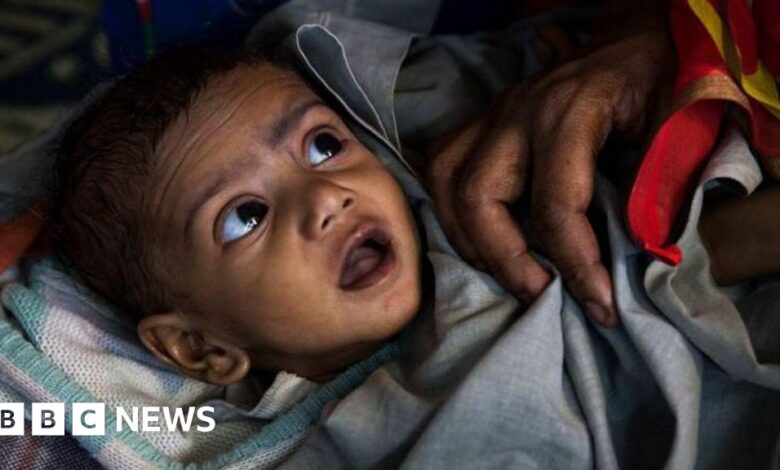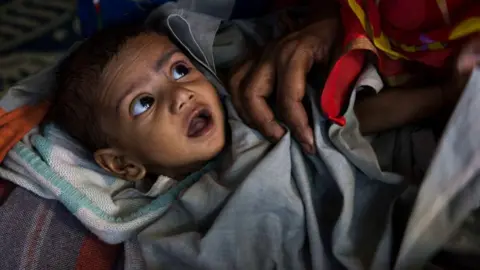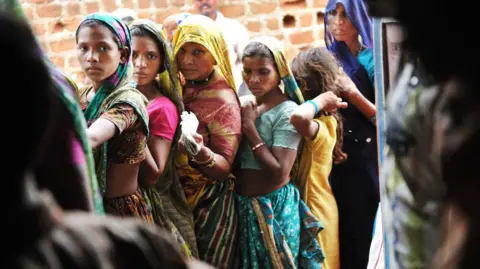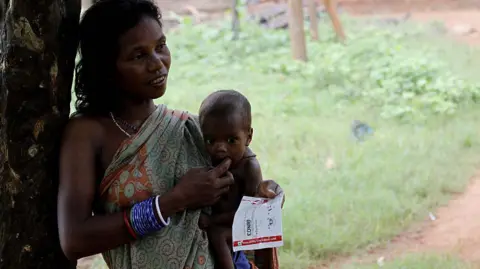Why does caste play a role in child stunting in India?

 Getty Images
Getty ImagesDecades of caste discrimination have contributed to India having higher rates of child stunting than across sub-Saharan Africa, new research reveals.
These two regions combined are home to 44% of the world’s under-five population but account for about 70% of globally stunted children – a key indicator of malnutrition.
However, although both have made significant strides in recent years, India’s rate stands at 35.7%with the average rate in 49 sub-Saharan African countries being 33.6%.
A child is considered stunted when he fails to reach expected height for his age – a clear sign of important nutritional deficiencies.
However, Research by Ashwini Deshpande (Ashoka University) and Rajesh Ramachandran (Monash University, Malaysia) found that focusing solely on the height gap – or why Indian children are shorter than children in sub-Saharan Africa – ignores an important factor: the important role of social identity, especially caste, in child malnutrition in India.
The first 1,000 days of a child’s life, often called the “golden period”, are pivotal: by age 2, 80% of the brain is developed, creating the foundation for lifelong potential. During these early years, access to health care, good nutrition, early learning and a safe environment will profoundly shape a child’s future.
India and sub-Saharan Africa, both with rapidly growing middle classes, young populations and significant potential workforces, have enduring comparisons. In 2021, the World Bank reported: “Sub-Saharan Africa and South Asia [including India] account for more than 85% of the global poor,” highlighting similar challenges in poverty and development.
 Getty Images
Getty ImagesUsing official data, the authors examined the most recent estimates of the stunting gap between India and a sample of 19 countries in sub-Saharan Africa.
Official data shows that more than 35% of India’s 137 million children under the age of five are stunted and more than a third are also underweight. Globally, 22% of children under 5 years old are stunted.
They then examined six socially disadvantaged groups in India. Among them are adivasis (tribal people living in remote areas) and Dalits (formerly known as untouchables), who alone make up more than a third of the population under the age of five.
Economists found that children from higher, non-stigmatized caste groups in India account for 27% – markedly lower than the proportion in sub-Saharan Africa.
They also found that children from higher caste groups in India were about 20% less likely to be stunted than children from marginalized groups, who were a person who occupies the lowest class in the caste hierarchy.
This conclusion remained significant even after taking into account factors such as birth order, hygiene practices, mother’s height, number of siblings, education level, anemia and menstrual status. socio-economic status of the household.
This disparity is despite seven decades of affirmative action, India’s caste system – the four-tiered hierarchy of the Hindu religion – remains deeply entrenched.
“This is not surprising because children from better-off groups in India have access to more calories and face a better disease environment,” the authors said.
 Getty Images
Getty ImagesThe reasons behind the high rate of stunting among Indian children have sparked a complex debate over the years.
Some economists have argued that the difference is genetic – that Indian children are genetically predisposed to be shorter in height.
Others believe that improved nutrition over generations has narrowed the height gap that was attributed to genetics.
Some studies have found that girls have worse outcomes than boys and others have found the opposite, using different global standards.
There is no doubt that stunting has decreased across social groups – a separate 2022 study found that improvements in health and nutrition interventions, household living conditions, and maternal factors have led to reductions in stunting in four Indian states. (More than half of children under age 5 in India are stunted, according to a 1992-93 federal family health survey.)
Children belonging to marginalized groups such as adivasis are more likely to suffer from malnutrition.
In Africa, stunting rates have also decreased since 2010, although absolute numbers are still increasing.
 Getty Images
Getty ImagesBut what is clear is that children from poor families, whose mothers have less education or belong to disadvantaged groups, are especially vulnerable to stunting in India.
“The debate about the height gap between Indian and sub-Saharan African children has led to a disregard for the role of social identity, especially caste status,” the authors said.
“This is an important aspect to understand the child nutrition burden in India.”
The analysis uses data from demographic and health surveys. For India, this includes the latest data from 2019-21, and for Sub-Saharan Africa, it includes data from 19 countries with surveys from 2015 onwards . The dataset includes anthropometric – measurements related to the physical size and composition of the human body – results of 195,024 children under 5 years old in India and 202,557 children under 5 years old in sub-Saharan Africa. Sahara.





